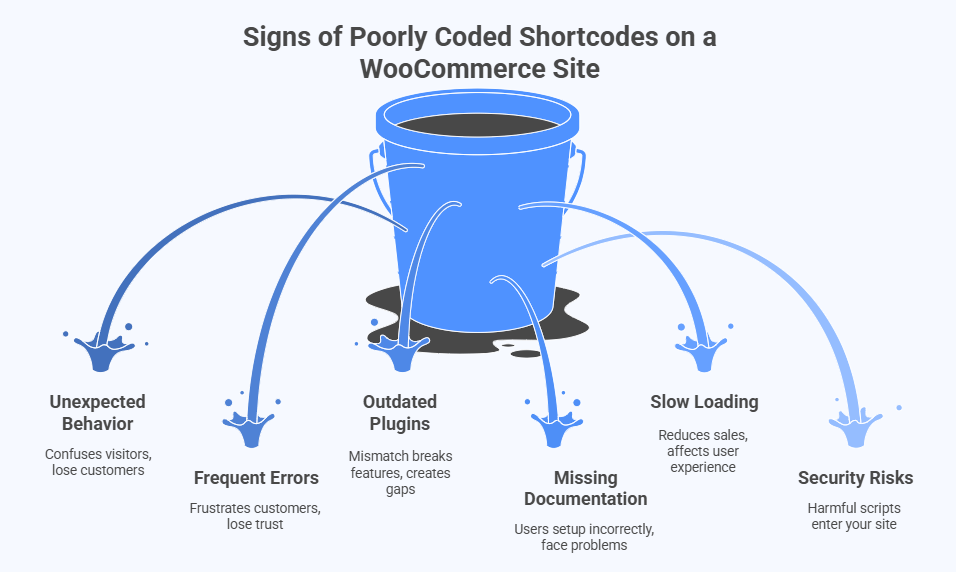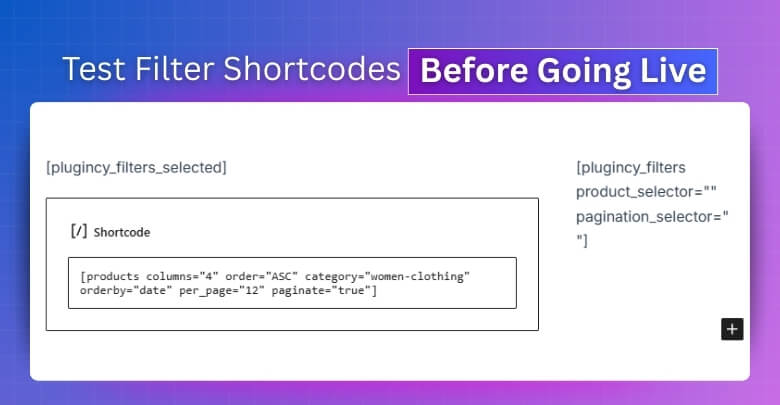Shortcodes play an important role in WooCommerce sites because they help manage and display content in a simple way. Many users rely on them for smooth shopping filters and a better user experience. Still, in the back of your mind, you may wonder, are filter shortcodes safe to use?
Filter shortcodes are safe to use if they come from trusted sources, have clean code, and are regularly updated. They should also be compatible with your website version, have limited access for users, and work with extra protection like security plugins. These steps make shortcodes secure and reliable.
Do you want to know how to check if your filter shortcodes are really safe or what makes them strong and risk-free? If so, then keep reading because this article shares every important detail you need to understand about the safety of using filter shortcodes on your website.
Are Filter Shortcodes Safe to Use?
Yes, filter shortcodes are generally safe to use if they are added correctly and come from a trusted source. They work as small tools inside your website to show or manage content. But just like any feature, their safety depends on how and where they are used. To know what makes filter shortcodes safe to use, check the points below.

Trusted Source
Filter shortcodes are safe when they come from reliable plugins or themes. If you install them from unknown or unverified sources, they may carry hidden risks. Always download from official websites or popular marketplaces. This lowers the chance of harmful code.
Trusted sources also provide better customer support. If something goes wrong, you can quickly get help to fix the issue. For example, many websites use advanced tools with shortcodes to improve shopping filters, and a popular choice is the Ajax product filter for WooCommerce, which is trusted and widely used. That is why trusted sources are always the best choice.
Code Quality
Good coding practices make shortcodes secure. When developers follow the right coding standards, it reduces errors and possible bugs. Poorly written code may create security holes in your site. That is why quality matters in keeping shortcodes safe.
Well-written code also makes your site load faster. Clean code uses fewer resources and runs smoothly on different platforms. Messy code often slows down performance and creates conflicts. In the long run, good code saves time and effort.
Regular Updates
Shortcodes are safer if the plugin or theme gets regular updates. Updates often fix security issues and improve performance. Ignoring updates can leave your site open to attacks. Always keep plugins and themes updated to stay safe.
Updates also bring new features that can improve your site. They remove old bugs that might cause trouble for users. A well-updated plugin works better with new platform versions. Regular updates show that the developer cares about safety.
Compatibility Check
Shortcodes should match the version of your website platform. If they are not compatible, they may cause crashes or security problems. Testing them on a demo site before going live helps avoid bigger issues. Compatibility ensures smooth and safe use.
When shortcodes work well with your platform, your site stays stable. Incompatible shortcodes can break layouts or stop features from working. This can create confusion for visitors and lower trust in your site. Proper checks prevent these types of problems.
Limited Access
Allowing only trusted users to add or edit shortcodes is important. If everyone can access them, the risks of misuse increase. Restricting access reduces the chances of errors or unwanted changes. Keeping shortcode control limited adds an extra safety layer.
Too many people editing shortcodes can cause mistakes. A small change in code can damage the whole page. By limiting who has access, you keep the site more organized. Fewer hands mean fewer problems in the long run.
Security Plugins
Adding a security plugin can boost protection for shortcodes. These plugins scan for malware or suspicious activities. They also block harmful code if it tries to run. Using them with shortcodes creates a safer environment for your website.
Security plugins give alerts if they find unusual behavior. This helps you act quickly before damage is done. They also provide extra tools like firewalls and backups. With these protections, your site remains stronger against threats.
How Do Filter Shortcodes Work?
Filter shortcodes in WooCommerce give store owners a simple way to add useful filters directly on shop pages. These shortcodes allow customers to sort products by categories, price range, or specific attributes with ease. By placing them on pages, widgets, or posts, visitors can find the right items faster. This saves time, makes shopping easier, and improves the overall browsing experience for customers looking for specific products.
Using WooCommerce filter shortcodes is not complicated, as they work like regular shortcodes placed within square brackets. For instance, integrating a WooCommerce price filter shortcode enables customers to choose items within their budget with ease. Similarly, a category filter shortcode helps show only products from chosen categories. This system makes product discovery smoother, helping customers get exactly what they want without going through endless pages.
The best part about these shortcodes is their flexibility in placement across different sections of the store layout. A filter can appear on sidebars, inside pages, or even within custom layouts, depending on design needs. This flexibility gives store owners control over how customers interact with the products. When used properly, filter shortcodes improve navigation, reduce confusion, and encourage buyers to stay longer and purchase more.
Signs of Poorly Coded Shortcodes on a WooCommerce Site
Shortcodes are very helpful in WooCommerce sites, but sometimes they can cause problems if not created or maintained properly. Poorly coded shortcodes may show small warning signs before turning into bigger site issues later. Paying attention to these signs is very important for keeping your site safe. Let’s look at some common warning signs you should watch for carefully.

Unexpected Behavior
One major sign of unsafe shortcodes is strange behavior on your site that was not there before. Pages may suddenly load incorrectly, and buttons may not work as expected. This can confuse visitors and make them leave quickly. If you notice changes after adding a shortcode, it is a clear red flag.
Frequent Errors
Shortcodes that are not coded well often lead to repeated error messages on your site. These errors may appear while loading pages or even while checking out. Such issues can frustrate customers and make them lose trust. When errors become common, it usually means the shortcode is unsafe.
Outdated Plugins
If the plugin that provides the shortcode has not been updated for a long time, it can be risky. Outdated plugins may not match with new WooCommerce or WordPress versions. This mismatch often breaks features or creates security gaps. Always check the update history before trusting the shortcode.
Missing Documentation
Good plugins and shortcodes always come with proper guides or instructions. If a shortcode does not include clear documentation, it shows poor coding quality. Without proper details, users may set it up incorrectly and face problems. Lack of documentation should be treated as a warning.
Slow Loading
Sometimes, unsafe shortcodes can make your site load much slower than usual. A slow site not only affects user experience but also reduces sales. Shortcodes with bad coding often add extra load on servers. When speed drops, it signals deeper issues.
Security Risks
Unsafe shortcodes can also open doors for hackers if they are not built carefully. Poor coding may allow harmful scripts to enter your site. This can put customer data and payments at risk. Always ensure your shortcodes come from trusted sources.
Poor Compatibility
A well-coded shortcode should work smoothly with themes and other plugins. If you notice conflicts, such as design breaking or functions stopping, compatibility is the problem. Poorly coded shortcodes often clash with other tools on the site. When conflicts appear, the shortcode might not be safe.
How to Test Filter Shortcodes Before Using Them on Live Sites?
Adding filter shortcodes can improve a WooCommerce store, but using them without testing may cause unwanted problems. A careful testing process helps avoid errors, slowdowns, or broken features on the live site. Many store owners skip testing and face bigger issues later. Here are some smart ways to test filter shortcodes safely.

Use Staging Site
The best place to test new shortcodes is on a staging site. This is a safe copy of your live website. You can add shortcodes here without worrying about affecting real customers. Any errors found can be fixed before moving them live.
Check Plugin Source
Before testing, always check where the shortcode is coming from. Trusted plugins with regular updates are usually safer to use. Avoid plugins that look outdated or lack good reviews. A reliable source reduces the chance of shortcode-related problems.
Test Different Browsers
Shortcodes may work fine in one browser but fail in another. Testing on multiple browsers like Chrome, Firefox, and Safari is helpful. This way, you can see if customers will face issues while shopping. If problems appear, you can fix them early.
Review Site Speed
After adding a shortcode, check if the site slows down. Slow loading can drive visitors away and hurt sales. Use free speed testing tools to compare site performance before and after adding the shortcode. If the shortcode affects speed badly, reconsider using it.
Watch for Errors
Keep an eye out for any error messages while testing. Errors may show on product pages, checkout, or admin sections. Even small issues can become bigger once the site goes live. Fixing them during testing saves a lot of trouble later.
Confirm Compatibility
Shortcodes should work smoothly with your theme and other plugins. If a shortcode breaks the design or disables functions, it is not compatible. Test them with different settings to confirm stability. A shortcode that works well everywhere is safe to use.
When to Consult a Developer for Filter Shortcode Integration?
Filter shortcodes can make your WooCommerce site better, but sometimes they may need professional help for safe setup. Not every situation requires a developer, but certain issues can be too complex for beginners. Knowing when to seek expert advice saves time and effort. Let’s look at situations where a developer’s help becomes very important.

Complex Customization
When you want shortcodes to work in very specific ways, customization may be needed. This could include adding product filters for large WooCommerce stores or creating unique designs. Such changes often require coding knowledge beyond normal settings. A developer can ensure customization is done correctly.
Frequent Site Errors
If adding shortcodes leads to constant errors on your site, it is a sign of deeper issues. Errors can break pages, checkout, or product displays. Fixing them without proper knowledge can make things worse. A developer can quickly find and solve these errors.
Plugin Conflicts
Sometimes shortcodes stop working because of conflicts with other plugins or themes. These problems may cause your site to crash or misbehave. Identifying the exact conflict is not always easy. A developer can trace the issue and fix compatibility problems.
Security Concerns
Unsafe shortcodes can sometimes pose risks for hackers or harmful scripts. If you feel your site is becoming unsafe after adding shortcodes, consult a developer. Security problems can affect customer data and payments. A developer ensures the site remains secure.
Speed Problems
Shortcodes can sometimes slow down a website if not optimized properly. A slow site may reduce sales and hurt rankings. If testing shows performance issues, a developer can optimize code and improve speed. This makes sure your site runs smoothly.
No Documentation
Shortcodes without proper instructions or guides can be confusing. Trying to set them up without details may cause mistakes. Developers know how to handle undocumented code safely. Their help ensures that the shortcode works without breaking other parts of the site.
Frequently Asked Questions
You may still have many small but important doubts about filter shortcodes and their safety. To make things simple, here are clear answers to common questions people ask. These FAQs will help you understand different sides of the topic that were not explained earlier.
How Do Filter Shortcodes Impact Website Performance?
Filter shortcodes impact website performance based on how they are coded and the number used. Clean and optimized shortcodes run smoothly without slowing the site. Poorly coded or excessively shortcodes may increase loading time, leading to a weaker user experience and lower conversions.
What Happens If Filter Shortcodes Are Not Maintained?
If filter shortcodes are not maintained, they may become outdated and vulnerable to attacks. Old code may stop working with new versions of WordPress or WooCommerce. This can create errors, security gaps, and reduced site stability, risking customer trust and sales.
Can Filter Shortcodes Be Misused by Hackers?
Yes, unsafe or poorly coded filter shortcodes can be misused by hackers if they contain weak points. Attackers may inject malicious code through them. Using secure plugins, firewalls, and scanning tools prevents misuse and keeps both the site and customer data safe.
How Do Filter Shortcodes Affect Site Speed During Peak Traffic?
During peak traffic, filter shortcodes that are not optimized may slow down the website because of increased server requests. Well-built shortcodes, on the other hand, handle high loads effectively. Safe shortcodes ensure smooth browsing for all visitors, even during busy sales periods.
What Problems Do Poorly Optimized Shortcodes Create in WooCommerce Stores?
Poorly optimized shortcodes create problems like slow page loading, layout conflicts, and reduced compatibility with themes. They may also cause higher server usage, leading to downtime on busy days. These issues lower customer trust and make the site appear unreliable.
Which User Permissions Should Be Given for Shortcodes?
Only admin-level or trusted users should be allowed to add or edit filter shortcodes. Giving access to too many users increases mistakes and risks. Limiting permissions keeps shortcode use organized and prevents accidental or harmful changes to the site’s structure.
How Do Filter Shortcodes Affect Website Analytics?
Filter shortcodes can affect analytics if they interfere with tracking scripts or page structures. Safe shortcodes keep product filtering smooth while still allowing analytics to capture user behavior. Unsafe or buggy ones may distort tracking data, leading to misleading reports.
Bottom Line
Shortcodes may look small, but they have a big impact on how a WooCommerce site works. They make shopping filters simple and improve the experience for visitors. With so much value, it is natural to pause and think carefully about their safety before using them.
So, are filter shortcodes safe to use? The answer is yes, as long as they come from trusted sources, follow clean coding practices, stay updated, and are tested for compatibility. Adding limited access and security plugins adds even more protection, making them reliable tools for your site.
If you are planning to use them or already do, paying attention to these points keeps your site safer and your visitors happier. Safe shortcodes mean smooth shopping, fewer problems, and better trust from your customers.
